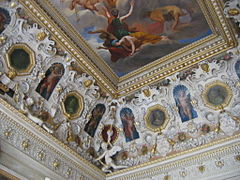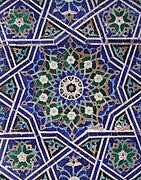Strapwork


In the history of art and design, strapwork is the use of stylised representations in
European strapwork is a frequent background and framework for
Scrollwork is a variant that tended to replace strapwork almost completely by the Baroque. It is less geometric and more organic, more three dimensional, and with emphasis on the curling ends of the "straps". The Italian artists at the Palace of Fontainebleau had already moved onto this by the 1530s,[3] but in provincial work in northern Europe flat strapwork panels continued for another century or more.
Where there is no suggestion of three dimensions – curling ends and the like – the decoration may also be called bandwork or "interlaced bands", the more technically correct term. Peter Fuhring derives this style from Islamic ornament.[4]
Italy
Strapwork designs, influenced by Islamic ornament, are found on tooled book-covers in Italy and Spain by the mid-15th century, and in other media by the early 16th century, for example in the
Flemish
The forms developed in
France
Strapwork was found earlier, but really came to prominence after it was used in
England
Strapwork became popular in England in the late 16th and 17th centuries as a form of plasterwork decorative moulding used particularly on ceilings, but also sculpted in stone for example around entrance doors, as at Misarden Park (1620), Gloucestershire, or on monumental sculpture, as on the frieze of the monument to Sir John Newton (d.1568), at East Harptree, Gloucestershire, and on that of Sir Gawen Carew (d.1575) in Exeter Cathedral. Wollaton Hall outside Nottingham makes especially extensive, and for some excessive, use of strapwork inside and out.
Islamic
Islamic girih uses complex patterns and interlace, but the form of the strips is generally simple, does not vary along their length, and no attempt to achieve a stylized impression of other materials is made. The patterns it used influenced European ornament in the Renaissance, through the Moresque style.[9]
Girih is an Islamic decorative art form used in architecture and handicrafts (book covers, tapestry, small metal objects) from the 8th century onwards. It consists of geometric lines that form an interlaced strapwork. Girih patterns are used in varied media including tilework, brickwork, stucco, wood (for example in minbar pulpits) and mosaic faience work.[10][11]
-
Sophisticated three-dimensional strapwork in stucco at the Palace of Fontainebleau
-
French bookbinding, 1552
-
French bookbinding, 1555 or after
-
The stone screen in the hall at Wollaton Hall outside Nottingham
-
Polish strapwork c. 1566, detail from Czarny mural monument, Church of St. Mary, Kraków
-
Modern reproduction harpsichord uses bandwork or strapwork motifs based on a Flemish book of 1579, mixed in with grotesque elements.
-
Samarkhand
Notes
References
- Fuhring, Peter, Renaissance Ornament Prints; The French Contribution, in Karen Jacobson, ed (often wrongly cat. as George Baselitz), The French Renaissance in Prints, 1994, Grunwald Center, UCLA, ISBN 0-9628162-2-1
- "Grove": Wells-Cole, Anthony, "Strapwork", Grove Art Online, Oxford Art Online. Oxford University Press. Web. 5 Feb. 2017. Subscription required








